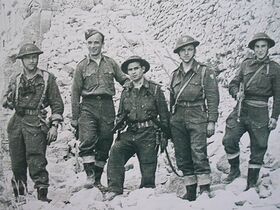Operation Tetrarch
This article is incomplete because it is pending further input from participants, or it is a work-in-progress by one author. Please comment on this article's talk page to share your input, comments and questions. Note: To contribute to this article, you may need to seek help from the author(s) of this page. |
| Operation Tetrarch | |||||||
|---|---|---|---|---|---|---|---|
| Part of the Middle East Campaign of the Second Europan War | |||||||
 The Victors of Tetrarch (Dalmascan, Galbadian, Alterian, Nibelheimian, Gallian) | |||||||
| |||||||
| Belligerents | |||||||
| Commanders and leaders | |||||||
| Strength | |||||||
|
230,000 troops 350 tanks 150 aircraft 75 guns |
300,000 troops 500 tanks 200 aircraft 90 guns | ||||||
| Casualties and losses | |||||||
| Light to Moderate | Heavy | ||||||
Operation Tetrarch (28 December 1942 - 29 January 1943) was an operation that called for Allied forces to take control of the southeastern regions of Afghania and to prepare for an Allied Invasion into Pakistania. In a stroke of coincidence, Imperial forces plotted one final counteroffensive in a bid to destroy Sugiyama's rear, calling for several Imperial reserve forces in Southern Pakistania to cross the border and attack the major city of Kandahar then swing north and attack Sugiyama's forces in the north, destroying the Allies effectively. However, by this time, fresh reinforcements arrived, including Dalmascan and Galbadian forces being reinforced and restructured after being led by General Nikolai Vilhelmsen, one of Dalmasca's celebrated commanding officers and a victor of several battles involving Dalmasca in North Africanna.
Vilhelmsen, aware of Quang's capabilities in the field positioned his forces and dug in at Kandahar. Vilhelmsen intended to bog down and dry the Imperial offensive at Kandahar. When the operation began, Quang ordered Duyen to conduct swift armoured thrusts along the Kandahar front. Although the Imperials expected the Allies to fall, they were astonished at the fact that they had managed to hold their ground for several days. In 12 January, Duyen managed to breakthrough and reached Kandahar at the cost of men and tanks. This enabled Vilhelmsen to initiate a war of attrition within the city, something which the Imperials did not expect. After only 4 days of being in Kandahar, the Imperial offensive had been bogged down. Marshal Quang then ordered Marshal Sazabio, Generals Le and Quang to maneuver through the weaker northern flank, breakthrough the defenses to enable the march to Khost while He, Duyen, and Sundermann would attempt to prevent Allied forces from going after them. The Imperials managed to breakthrough the northern flank and the march commenced. But Alterian and Nibelheimian forces caught this force from the rear and clashed at Bamizay in 24 January, where the Allies managed to blunt and split the Imperial force into two, with the Imperials forces in the north of the split being encircled by Alterian forces. Quang attempted to rejoin the two forces but to no avail and was eventually forced to call off the march. By 27 January, Marshal Quang could no longer mount an effective attack to attempt to regain the initiative and ordered a retreat back into Southern Pakistania. Vilhelmsen gave chase and arrived at the border by 1 February.
Although the Allies only had the Secondary forces led by Dalmasca in the operation, the Secondary Allies had learned from its lessons during its misfortunes at the [[1937 Winter Campaign and began fielding competent commanders who restructured formations and restored confidence within the army, drastically raising army morale. The failure of the Imperials to regain the initiative in the Middle East marked the end of Imperial operations in the region, with Operation Tetrarch being the last battle that the Imperials took part in the Middle East.